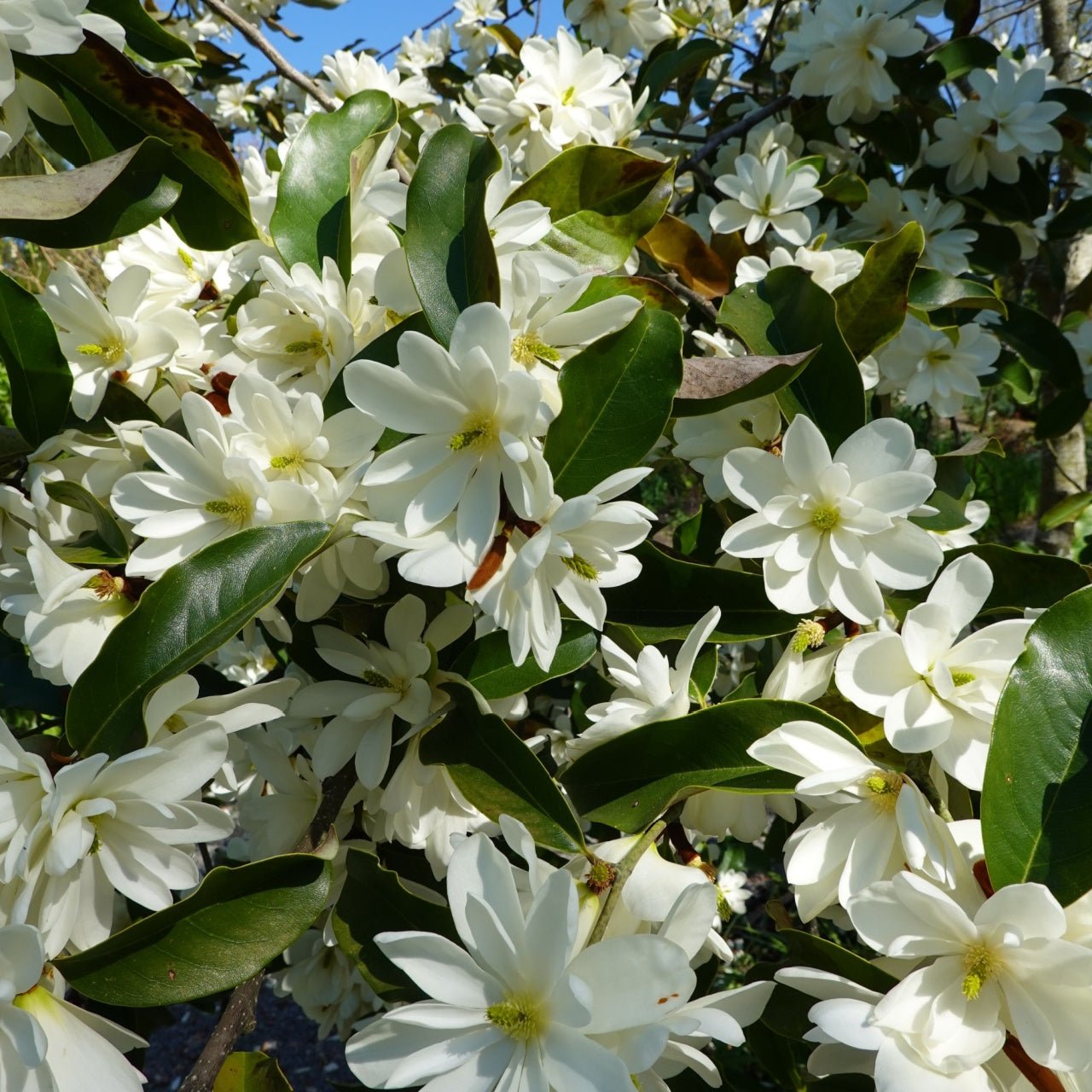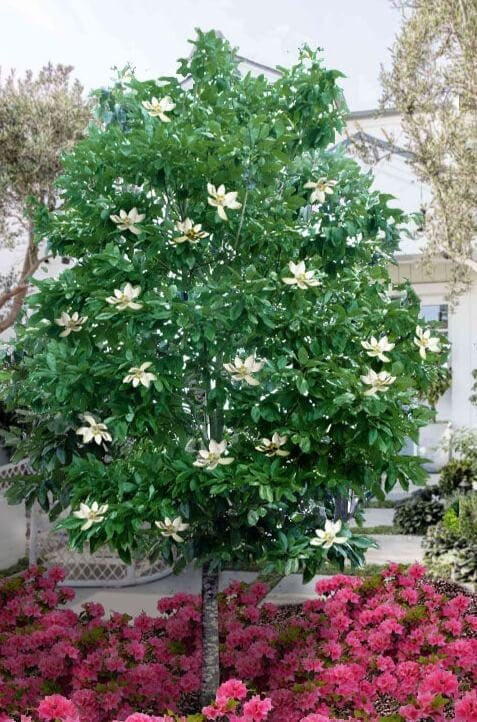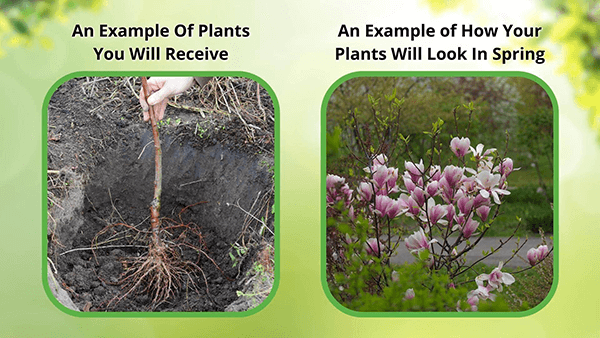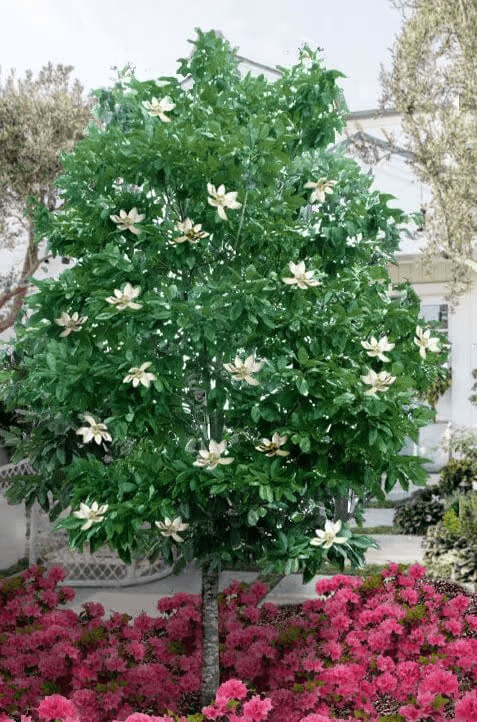



Sweet Bay Magnolia Tree
Evergreen foliage for year-round beauty
Attractive, glossy green leaves
Resilient in various soil types
Thrives in
ZONE 5ZONE 6ZONE 7ZONE 8ZONE 9ZONE 10This plant ships:
November 20251 Year Guarantee on all plants
Sweet Bay Magnolia Tree - Magnolia virginiana
The Sweet Bay Magnolia Tree (Magnolia virginiana) is an elegant deciduous tree that is native to eastern United States. It grows to heights of 35 ft and equally as wide. They naturally grow in swamps and shaded woodlands. It has a spreading and open crown formation as a tree, and as a shrub, it is multi-stemmed and suckering. The leaves are an attractive deep green on the upper portion with soft pubescens on the underside. This shrub is long-lived and can thrive for up to 150 years.
This shrub has enticingly aromatic bark and leaves that have been used for a myriad of purposes. Some evidence suggests that once introduced to Europe in the 1600s, the bark was used in traps to lure animals in to be captured. This unique shrub has a long history of medicinal use as well. The bark of this beautiful shrub was used by indigenous tribes as a tonic, a stimulant, and as an anti-inflammatory.
Plant Details - Sweet Bay Magnolia Tree
Family: Magnoliaceae
Hardiness Zones: 5–9
Light Requirement: Full sun to partial shade
Water Needs: Moderate to high
Height: 10 - 35 ft
Spread: 10 - 20 ft
Growth Rate: Moderate
Bloom Time: Late spring to early summer
Flower Color: Creamy white
Wildlife Value: Flowers attract bees and beetle pollinators. Red seeds are eaten by birds and small mammals
The flowers are fragrant with a fresh, lemony scent and are thick, fleshy petals that are delightful to the touch. Creamy white in color, they develop to be 3 in in diameter to form a bowl-shaped flower. Interestingly, the flowers open up in the day and close at night over 2-3 days.
The fruit of the Sweet Bay Magnolia Tree is bright, candy apple red in color and they mature in late summer. The fruit attracts a number of birds to feast when ripened adding wildlife to your garden.
Landscape Uses and Maintenance - Sweet Bay Magnolia Tree
This plant virtually pest and disease free and easy to grow. It prefers moist to wet, rich and acid soils. Best flowering is achieved in full sun locations; however, it will grow well in partial shade.
It makes an excellent specimen tree for your yard or along a woodland border. Make sure to plant this shrub with a fair amount of space between individuals as they need room to spread.
Noteworthy Characteristics
Aromatic bark and leaves, prolific flowering, easy to grow
The showy, fragrant, creamy white flowers of this delightful tree are sure to boost the aesthetic of any garden space or woodland border. Shop for Sweet Bay Magnolia Tree online at TN Nursery. For 68 years, we have served the landscaping industry and homeowners with specimen plants.
This Is How Your Plants Will Look upon Delivery

Bloom Season
Spring
Bloom/Foliage Color
White
Height at Maturity
Over 25 Feet
Care
Sweet Bay Magnolia thrives in well-drained, acidic soil and prefers regular watering to maintain consistent moisture. Mulch near the ground to keep moisture and prevent weeds. Trim in late winter to shape and release dead branches. Fertilize in early spring for best growth.
Plant Reproduction
Sugar Sweet Bay Magnolia spreads through suckering and wide canopy growth.
Plant bare root trees during the dormant season in early spring or late fall (November through April). Dig the hole twice as wide as the roots so the soil is well-drained. Position the tree so the root flare is at or just above ground level. Fill the hole back with the soil you dug from and water. Maintain soil moisture, especially in the tree's early years, by providing deep, regular watering. Apply a 2-4 inch mulch away from the trunk at the base to retain moisture and suppress weeds. Prune trees during the first few seasons to establish strength and resilience, remove damaged branches, and continue maintenance pruning as the tree matures. Regularly inspect for pests and diseases and apply integrated pest management practices. Protect young trees from mechanical damage and extreme temperatures with tree guards, and stake them if necessary for support, removing the stakes after one or two years.
Shipping date depends on the date displayed and chosen when you order from the product's page.
We only accept returns on plants verified dead. If you think your plants have died, we offer a 1 year warranty, please use this File a Claim Link to verify dead plants and start with return warranty process.






Elegant Evergreen Foliage:
The Sweet Bay Magnolia boasts lush, glossy leaves that provide year-round greenery and a sophisticated look.
Fragrant White Blooms:
Enjoy beautiful, creamy-white flowers in late spring and summer that fill the air with a pleasant, sweet fragrance.
Compact Size:
Its moderate size makes it perfect for both small and large gardens, fitting well into various landscape designs.
Beautiful Bark:
The tree features smooth, light-gray bark that adds visual interest and complements its overall appearance.
Caring Tips
How do I care for my Sweet Bay Magnolia Tree?
Each box contains detailed care instructions and information about your product. But here's the basics.
Care Tips
Sweet Bay Magnolia thrives in well-drained, acidic soil and prefers regular watering to maintain consistent moisture. Mulch near the ground to keep moisture and prevent weeds. Trim in late winter to shape and release dead branches. Fertilize in early spring for best growth.
Light Requirements
The Sweet Bay Magnolia succeeds in full sun to partial shade. Ideally, it should acquire at least 4-6 hours of natural sunlight daily. It can tolerate shade but generally performs best with ample sunlight for robust growth and flowering.
Hardy Planting Zones
5 • 6 • 7 • 8 • 9 • 10
Header
Use this content to share information about your store and products.
Frequently Asked Questions
How often should I water my plants?
How do I know if my plant is getting too much or too little sunlight?
What should I do to prepare my plants for winter?
What are the signs that my plant needs fertilizing?
How can I prevent pests from damaging my plants?
How do I choose the right plant for my climate zone?






